#Greater Prairie Chicken
Photo
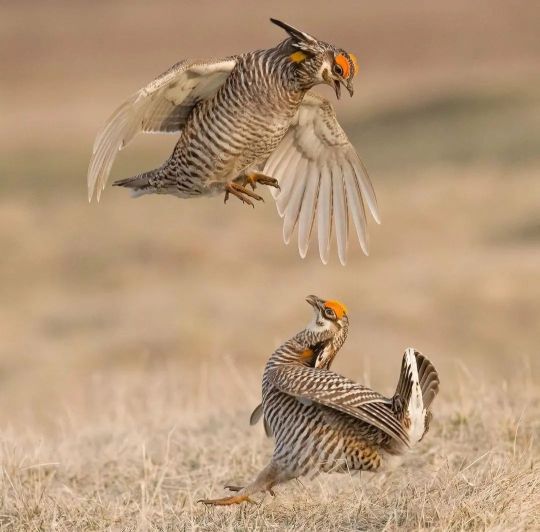
Greater Prairie Chicken
1K notes
·
View notes
Note
may i offer: the fashionable greater prairie chicken :]
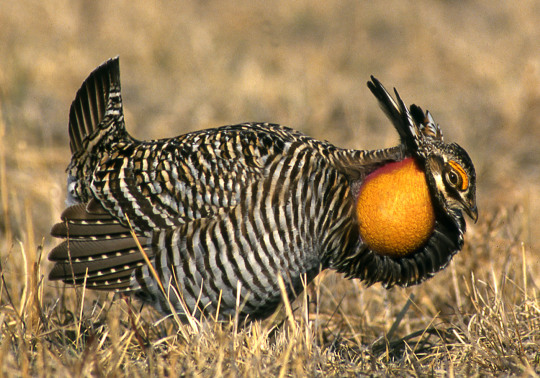

such a cool bird!! :-)
#asks#requests#art#traditional art#birdblr#bird#grouse#greater prairie chicken#ty for sending this in! had fun drawing it#tbh i didnt even know these were an animal til i saw your ask.. always a delight to find out about more creatures for the first time :D
39 notes
·
View notes
Text
BOTD: Greater Prairie Chicken
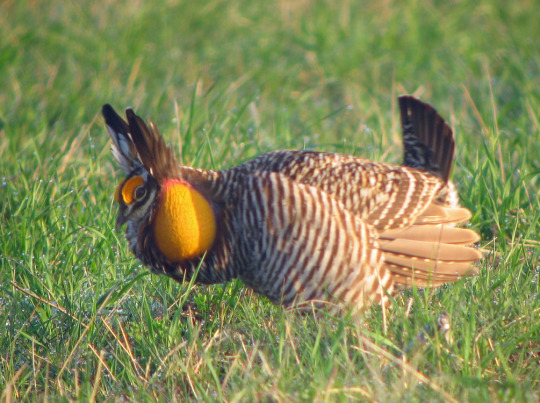
^Image credit: Greg Schechter
Greater Prairie Chicken (Tympanuchus cupido)
Also known as the Pinnated Grouse, and sometimes given the nickname 'Boomer', the Greater Prairie Chicken is famous for their mating ritual known as booming, in which the males go to their 'booming grounds' and perform a dramatic display to attract females, which involves inflating their orange air sac and snapping their tails.
#greater prairie chicken#prairie chicken#pinnated grouse#weird and wonderful#birds of north america#birds of america#grouse#tympanuchus cupido#birdwatching#birding#weird birds#weird animals#animal facts#bird facts#bird of the day#botd#bird-of-the-day#bird fact#bird fact of the day#birds#bird#bird lovers#birb#birbs#borb#borbs
164 notes
·
View notes
Text

The male greater prairie chicken performs his “booming” display with a group of other hopeful suitors, called a lek. Females gather to judge some eight to 20 males (pictured, an animal at Caldwell Zoo in Texas) at a time as they strut their stuff, usually on a low hill.
PHOTOGRAPH BYJOEL SARTORE
#joel sartore#photographer#national geographic#greater prairie chicken#bird photography#caldwell zoo#texas#animal#nature
14 notes
·
View notes
Text
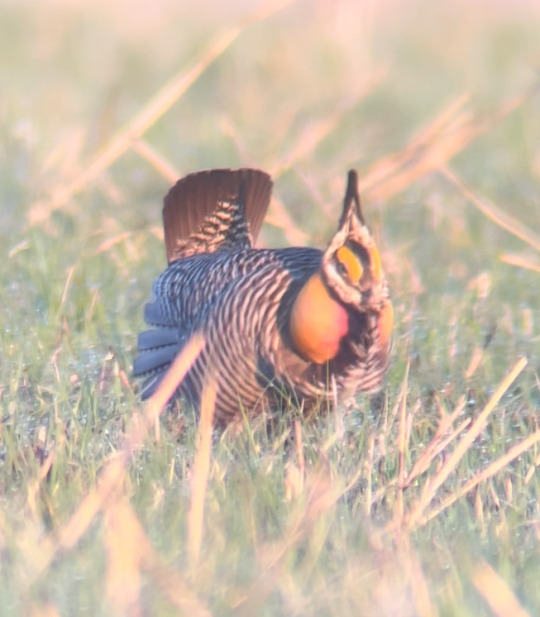
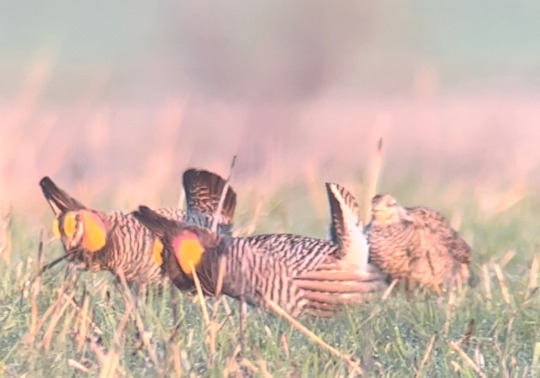
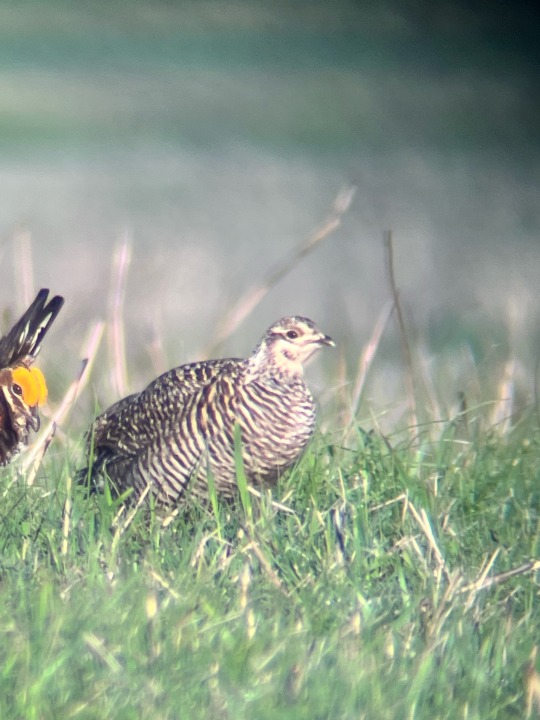

PRAIRIE CHIGGENS
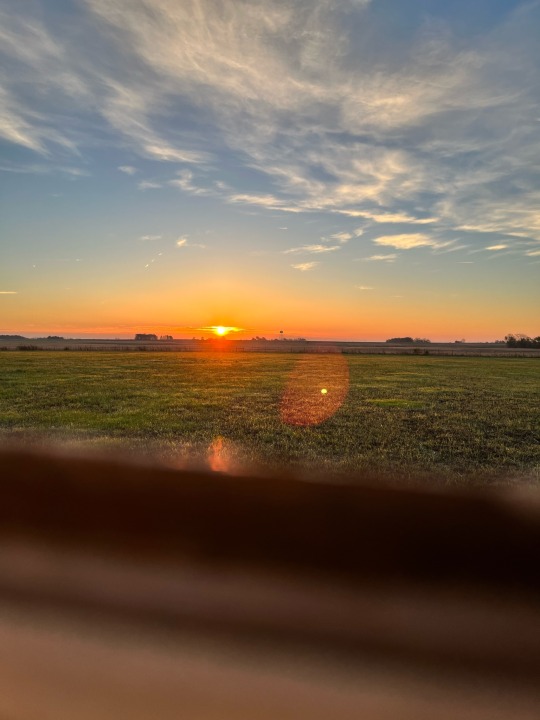
(Copulation vid) suggestive ??? it’s BIRDS. Who Cares
DONT SABOTAGE THEM!!!!!!!! 💔💔💔
This may have been an unsuccessful copulation actually because it was interrupted halfway through so hopefully the male passes his genes to the offspring… the female can just find another lek if she needs to, which they usually do
The female only lays one clutch btw!! She has to choose a good male for the best genes. There was only one female in this lek and 13 males so there was a lot of pressure. She left an hour or so after this
3 notes
·
View notes
Photo





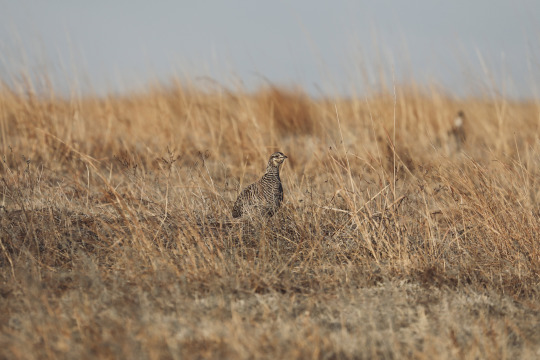




Snow Geese and Greater Prairie Chickens on a lek site in North Platte, Nebraska
Taken April 2022
#nebraska#great plains gothic#greater prairie-chicken#birds#snow geese#prairie#sunrises#my photos#my places#thv
297 notes
·
View notes
Text
Meet Bob & Mike my gay prairie chickens lol


#ZAWA#Minecraft#greater prairie chickens#omega minecraft server#It my birthday#so have some gae chinkens#I love them they look like they're blushing#I wanna draw them
10 notes
·
View notes
Text

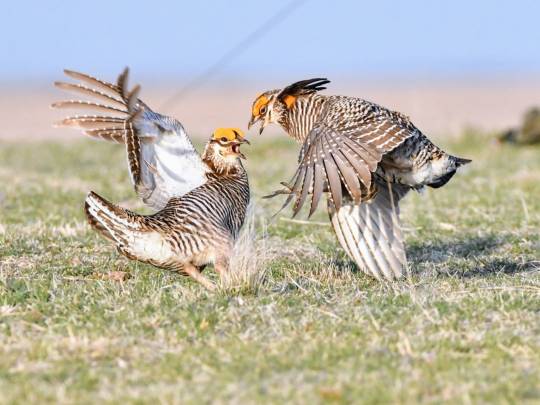

Greater Prairie Chickens (Tympanuchus cupido), displaying and engaged in ritual dance off-combat, family Phasianidae, order Galliformes, Phillips County, KS, USA
photograph by Tom Duncan
#prairie chicken#grouse#tympanuchus#galliformes#phasianidae#bird#ornithology#animals#nature#north america
613 notes
·
View notes
Text
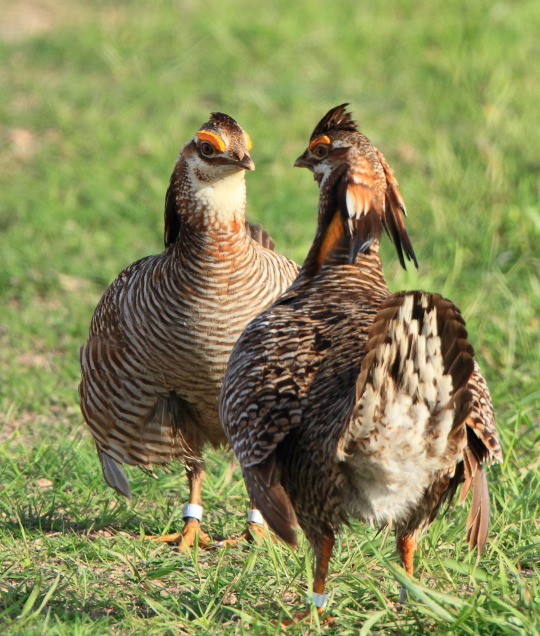


We are coming up on courtship and breeding time for the Greater Prairie Chicken, and then includes our Texas Gulf Coast, native sub species, the Attwater's Prairie Chicken, which is endangered. 
The males will be establishing their leks soon, in April, where they will be shipping off for the females.
The reason for endangerment is pretty predictable, destruction of habitat, as of course, 99% of North American native prairie has been destroyed. They also are having a hard time recovering because of introduced plants and fire ants. 
Have a look at the photos above of males displaying, all three photos by the US Fish and Wildlife Service. 
106 notes
·
View notes
Text
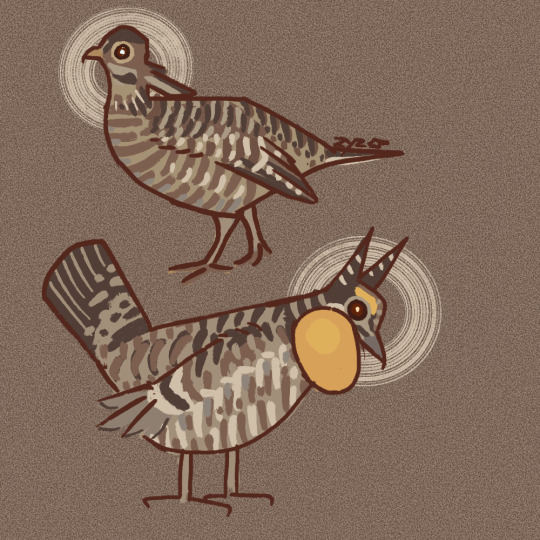
Day 8 of January extinct birds - the heath hen (subspecies of the greater prairie chicken.
Only some quick doodles today but at least two birds?
The heath hen is not its own species but I thought its extinction is interesting enough to include it! At around 1840-1870, no heath hens were left on the mainland, but a few hundred were left on the island of Martha's Vineyard. The number declined to roughly 70 when protection came in the form of a hunting ban and a reserve, and the population rocketed in the next few years. Unfortunately 1916 saw a range of challenges, including a devastating fire. The fire was able to reach its scope due to people protecting the reserve from natural fires! Numbers recovered a little but started dropping again because of the inbreeding from the two genetic 'bottlenecks'. The endling male died in 1932, having spent three to four years alone.
On a brighter note, the organization Revive & Restore is actually aiming to bring back the heath hen, amongst other cool things!
60 notes
·
View notes
Text
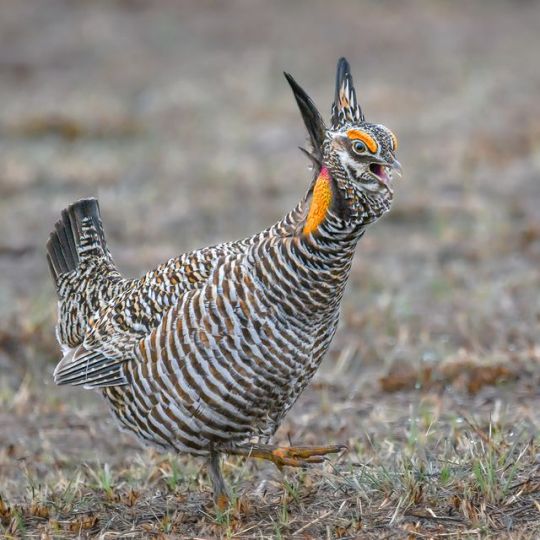

Greater Prairie Chicken
#greater prairie chicken#prairie chicken#Tympanuchus cupido#Galliformes#Phasianidae#Tympanuchus#bird#upl
24 notes
·
View notes
Text

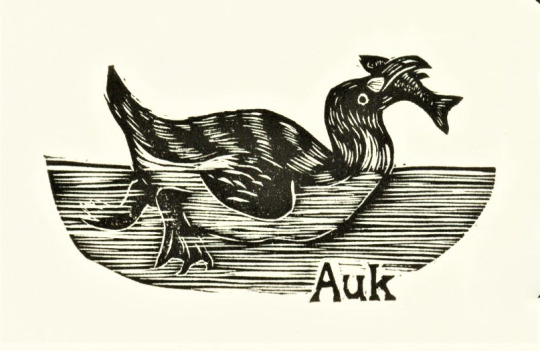


A Gone World Feathursday
Yesterday, we featured some woodcuts by the New Jersey-based artist Michael Dal Cerro (b. 1953) from his recently-donated 1992 artists book Small World Alphabet published in Seattle by Grey Spider Press in a limited edition of 75 copies. The book is an abecedarium highlighting the outsized impact our species has had on our planet's environment. Today we show all the woodcut birds presented in his book, and of course the unifying factor between these specific species is that they have all gone extinct through human intervention:
Dodo (Raphus cucullatus): a large flightless bird that was endemic to the island of Mauritius, part of a clade of extinct flightless birds that were members of the family which includes pigeons and doves. This docile bird that had never known predators was hunted to extinction by the late 17th century.
Great Auk (Pinguinus impennis): a large sea-going flightless bird of the family Alcidae that became extinct by the mid-19th century due to overhunting, particularly for its valuable down feathers used in pillows.
Heath Hen (Tympanuchus cupido cupido): an extinct subspecies of the Greater Prairie Chicken (Tympanuchus cupido), a large North American bird in the grouse family. Once extremely common, it became extinct in 1932, due to centuries of overhunting, predation by feral cats, and poaching.
Passenger Pigeon (Ectopistes migratorius): a migratory species of North American pigeon, once the most abundant bird on the continent, that was hunted to extinction by 1914.
View other posts on extinct birds.
View more Feathursday posts.
#Feathursday#extinct birds#Michael Dal Cerro#Small World Alphabet#Grey Spider Press#woodcuts#Dodo#Great Auk#Heath Hen#Passenger Pigeon#woodcut artists#abecedarium#abecederia#fine press books#fine press printing#birds#birbs!
141 notes
·
View notes
Text

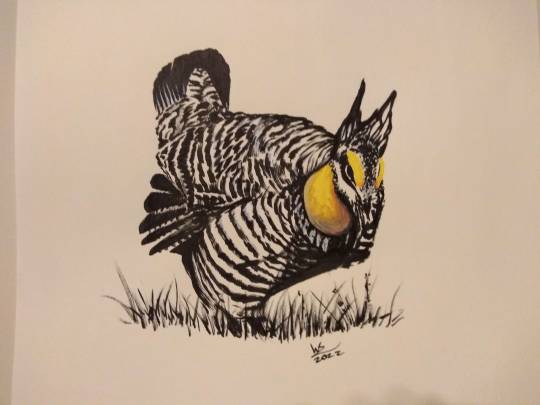
Wild turkey, greater prairie chicken
from the sketchbook too big to fit in my scanner... my photography skills are a little lacking here
237 notes
·
View notes
Text

Red Cedars on the Move, Eating Up Grasslands.
One of the biggest threats to Great Plains grassland ecosystems today is woody encroachment by invasive redcedars. Once grasslands are converted into woodlands, prairie wildlife species are lost, along with grassy areas for livestock grazing. As new woodland bird and wildlife species move in, they eat and expel the powder-blue cedar berries—and seed the advancing wave of cedars across the prairie. From left to right: pronghorns, Bobolinks, Eastern Meadowlark, cows, Burrowing Owls, Greater Prairie-Chicken, American Robin, Cedar Waxwings.
Illustration by 2023 Bartels Science Illustrator Maria Klos.
17 notes
·
View notes
Note
Love, love, love the birds worldbuilding in Himring.
I've actually been digging through links looking for birds that occupy Nan Elmoth and the surrounding area - Himlad, northern Estolad, the banks of the Celon.
Any thoughts about the flying critters living around there?
I’ll start with Himlad!
Flora, fauna, geography and environment masterlist
Himlad was a realm in Eastern Beleriand, bordered on the West by the river Aros and on the East, its tributary, Celon. It means ‘cool plain’ in Sindarin and was described simply as a cold region, likely due to its proximity to the March and thus to the Iron Mountains, the cold fronts of which extend throughout the surrounding regions.
I have imagined it as a steppe environment with an ecology similar to Mongolia. We have little information on environment other than the description of cold but some speculation can be done due to the habitat and through looking at similar real habitats, mostly in Northern Europe and temperate parts of Asia as well as parts of North America which Tolkien was inspired by the prairies in (source: The Flora of Middle Earth)
As always I include world building notes at the end so it’s not just a list of species! And as always please consider the list incomplete! There are so so many birds and I often go back to add more. Feel free to request a more specific prompt to focus on or a more specific family of birds
In the plains and steppe: tawny pipit (migratory, traveling west in the winter), David’s snowfinch, brown accentor, Siberian stonechat (also found in shrubs), rosy starling, swan geese, steppe partridge, pallas’s sandgrouse, great bustard, common cuckoo (migratory), cornrail (migratory, avoids the more arid parts), bearded vulture, crested lark, golden eagle, steppe eagle, imperial eagle, grey faced buzzard, ring necked pheasant, hazel grouse, black grouse, blue rock thrush, common quail, horned owls, gray partridge, desert warbler
Roosting in the sparse trees and shrubs: Yellow browed bunting, common rosefinch, fieldfare, stock dove, common nightjar, little owl, pine bunting
River shores: snow bunting (migratory), red necked crane (migratory), greater painted snipe, osprey, coturnix quail, grey heron, hen harrier, white throated dipper, bank swallow
Other: fork-tailed swift (migratory, mainly aerial), white headed duck, house sparrow, brambling (migratory), song thrush (migratory), black billed caper, northern wren
World building notes:
-Hunting with eagles and other birds of prey is more common than in the other Fëanorian realms (though most utilize birds at least sometimes). Golden and steppe eagles are used primarily by Celegorm and his loyal servants; these are huge and beautiful birds whose use is in some ways a boast of the skill of their handlers
-Celegorm’s knowledge of the language of birds is highly utilized for the defensive and offensive projects of Himlad. Though his followers do not for the most part have this gift they are highly skilled in using tracks, traces and conditions to understand the presence of local birds and the implications thereof. They know what to make of the stray tail feathers of a steppe partridge versus the presence of molt. They know the difference between the tracks of
Of course this applies to other creatures besides birds but as this post is about birds…
-Grouse and quail are sometimes kept for meat and eggs though different species of quail then are kept by the Marchwardens of Doriath. Some of the species are brought from Estolad, Ossiriand or Western Beleriand. The birds are housed in large open pens with small nesting boxes. 
-There are also domestic species of chicken, peacock and quail like birds that are kept for similar reasons. Hybrid species, sometimes with native species, occur naturally and through planned breeding projects during the Long Peacd
-The camouflage of steppe creatures including birds is often used in the fashion of Himlad’s soldiers.
-The various sections of archers among the army and scouts are distinguished by varying types of feathers used in their arrows. For example, Swan goose feather is used for the scouts that patrol the borders and rivers, swift feathers are used among the smaller more specialized groups and golden eagle feathers are reserved for the archers who will be first in the lines of offensive movements.
-Game birds are hunted for meat though all parts are used. Bird bones are actually highly utilized by the host of Himlad, in jewelry and headwear as well as whistles and other tools.
As always please feel free to ask more!
33 notes
·
View notes
Text
I'm watching a documentary about keystone Prairie species and they showed Prairie Chickens (Tympanuchus spp; couldn't tell if Greater or Lesser, it was so brief) and I am crying. I love my stupid Prairie Chickens and everyone needs to know about their stupid little faces.

ETA: There's this dude straight up just standing in a field in this documentary, identifying birds around him purely by song alone in rapid fire, and holy shit I'm jealous of his skill! This is one of the hardest skills to learn in Birding and he's really just rapid firing away like that! It's amazing!
6 notes
·
View notes